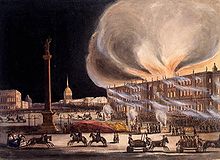Fire in the Winter Palace
This article needs additional citations for verification. (December 2020) |
 Fire in the Winter Palace, 1837, Watercolour by B. Green, 1838 | |
| Date | December 13, 1837[citation needed] |
|---|---|
| Duration | 3 days |
| Location | Winter Palace of Saint Petersburg |
| Cause | Soot inflammation |
| Deaths | 30 |
The fire in the Winter Palace of
The Palace burned for three days, and the glow was visible for 50–70 versts (50–75 km / 30–45 mi).[2] Thirty guardsmen died in the fire, although nearly all the items were saved (notably the imperial throne, guards banners, portraits of Russian generals from the Field Marshals' Hall and Military Gallery and the utensils of the Grand Church).
Events
The fire broke out after smoke from an unswept chimney had seeped through an unchoked vent in a partition between the wooden and main walls in the Field Marshal's Hall.[1] The wall began to smoulder and a fire broke out in the roof of the Small Throne Room of the Winter Palace.[1] The dry-waxed floors and the oil-painted fretwork caught fire immediately.
The Court was at the
To prevent the fire from spreading to the Hermitage, Nicholas I called for the immediate dismantling of the gallery roofs which joined the Hermitage with the main building.[1] However, the fire fighting was hindered when the privy-councilor of the Empress, Chambeau, stated: "Everything here belongs to the Empress! Not a thing must be broken!"[1]
A battalion of the
The official reports stated that there were no casualties until an eyewitness, Kolokoltsov, revealed the figures in 1882.[citation needed]
Restoration
The

